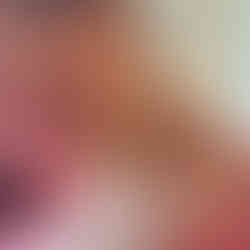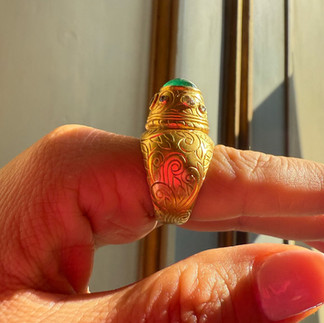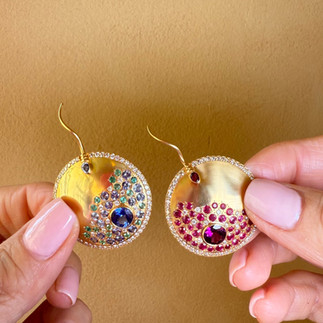“Rachel Saidani: The Psychology of Gold and the Soul of Creation”
- Shohista Turdiyeva
- Nov 12
- 6 min read

In the universe of contemporary jewelry, Rachel Saidani stands apart. Her journey — from psychology to fashion and finally to jewelry design — reveals a profound fascination with the human soul, identity, and the enduring symbols that bind us to nature and one another.
“My psychology studies did not precede my work in fashion, but rather ran parallel to it,” she reflects. “Without knowing it in advance, they allowed me to grasp the complexities of the human soul. Jewelry and adornment are unique to humanity. Through them, beliefs, desires, and fantasies are expressed — the very subjects of psychology and psychoanalysis.”
I sat down with Rachel Saidani during Milan Jewellery Week and she has shared her answers with me below; Please let me know what you think of it. -:)
JP: Your journey from psychology to fashion design, graphic design, and finally jewelry design is remarkable. How did your background in psychology influence the way you approach creating meaningful, talismanic jewelry?
Rachel Saidani:
My psychology studies did not precede my work in fashion, but rather ran parallel to it. Without knowing it in advance, they allowed me to grasp the complexities of the human soul. Jewelry and adornment are unique to humanity. Through them, beliefs, desires, and fantasies are expressed, which are also the subject of psychology and psychoanalysis.
JP: You’ve identified rings as your favorite item to design. What is it about crafting rings, as opposed to other jewelry, that feels so personal and powerful for you?
Rachel Saidani:
The ring, worn on the finger, the most prized piece of jewelry, is the main element of adornment, it is the reflection of personality. A symbol of status, wealth, power, the ring is also what seals the oath of love, it signifies a loving or even friendly commitment, it represents identity and, as such, it provides a foundation, gives weight to the gesture, thus facilitating human relationships. And then, unlike the necklace or the earring, we can contemplate it, observe its contours, the details that are revealed little by little and as we adopt it.
JP: The “Au long cours…” collection draws from Antiquity and the Orient, where jewelry carried fortune for nomadic peoples. How do you ensure these ancient traditions remain authentic in your modern designs, and what research process do you follow?
Rachel Saidani:
For me, jewelry is above all a talisman, a lucky charm designed to attract the favor of the gods. As such, it represents the subject. That is why I wanted to create unique pieces. A uniqueness that is also expressed through the irregularities they owe to the hand that shapes them.
A crystallization of superstitions and beliefs, an insignia of prestige or glory, even an instrument of seduction, jewelry sums up civilization as a whole. It is also an extraordinary experimental laboratory that artists use to reinvent the world.
What’s more, today jewelry is no longer just a fetish, but also an investment, just like a piece of art.
Wearing jewelry is like carrying your fortune with you, as in ancient times on the roads, jewelry being perhaps the most condensed form of fortune.
JP. What do you think about the telluric dimension?
Rachel Saidani:
The almost pure gold gives the telluric force to my rings, while the shape pointing towards the sky expresses the impulse towards spirituality and the attraction to higher forces.
JP: Using 22-carat solid gold, described as the color of antique, almost pure gold, gives your “Au long cours…” rings a distinctive look. What challenges or rewards come with working with such a pure material, and how does it enhance the talismanic quality?
Rachel Saidani:
I can only see advantages to working with 22K gold. It is less soft than 24K gold, which was used in ancient times, due to the addition of silver and copper. My rings are unique pieces, entirely handmade, as is the engraving, and 22-karat gold lends itself perfectly to this.
Thanks to 22K gold, the color is absolutely sunny. I use it in its most natural form, with very little polishing to preserve the authenticity of pure gold as it is extracted from the bowels of the earth. The irregularity of the hand that shapes the jewelry, the intense yellow color, and the matte finish give my rings their distinctive look.
JP: The rough-cut stones in your rings are said to crown them with a primal energy. How do you select these stones to ensure they embody the universal, gender-neutral power you aim to transmit to wearers?
Rachel Saidani:
Since my creations are unique pieces, I have to choose raw materials that can be adapted to my designs. This also allows me to choose raw materials that contain imperfections, in order to obtain a unique and living stone that bears the imprint of its geological history. This is surely where their primal energy comes from — an explosion from the depths of the earth.
JP: The “In the beginning…” collection, inspired by raindrops on a train window while visiting your parents, celebrates the union of masculine and feminine. How did you translate this fleeting natural moment into a bold manifesto about the origin of the world?
Rachel Saidani:
During regular visits to my parents, these raindrops on the train window caught my attention every time. In psychoanalysis, association is what allows us to access truth. These beautiful and lively raindrops suddenly became associated in my mind with sperm, perhaps precisely because I was going to meet the authors of my conception!
Currently, there is a kind of erasure of the masculine. Today, the origin of the world is primarily female. I wanted to remind people that it is also male. Humanity cannot survive the suppression of otherness. I seek reconciliation and harmony with and within nature. In my opinion, human reproduction is a theme of nature in the same way as plants, animals, and the cosmos, which are prized by the great jewelry houses.
JP: With pieces like earrings, bracelets, and necklaces in 18K gold set with vibrant stones like tanzanite, sapphire, and ruby, how do you use color and form to convey the playful yet provocative idea of life as a “race” and an “adventure”?
Rachel Saidani:
In my collection, there is not only the sperm, which I have greatly stylized so as not to overly frighten sensitive souls. The ovum, that is to say the feminine, is well represented. In fact, it has the privilege of being composed of many fine and precious stones, including the corona radiata, which is made of diamonds.
As you know, it is the egg, the female, that chooses a single sperm for fertilization. May the best one win! Our existence is like this race to give life. It is worth trying to live intensely. Also, through the colors and brilliance of the stones associated with gold, I wanted to restore the preciousness of our humanity and its immense diversity, as well as the hasard of encounters that characterizes the human adventure. But there is one unique color that humans share, and that is the color of blood, red, which flows through all veins.
JP: Both collections emphasise jewelry as amulets that protect, bring luck, and stand outside fashion trends. How do you hope wearers feel when they put on one of your pieces, whether it’s a ring from “Au long cours…” or a necklace from “In the beginning…”?
Rachel Saidani:
A piece of jewelry is not insignificant; its symbolic value is paramount. We place all our beliefs and hopes in it. I like jewellery that brings good luck and protection, as in ancient times. I like my creations to evoke strong emotions, which is why they do not feature recurring, conformist shapes such as clovers or other easy symbols. Conformity kills singularity.
The subject of my collection, “In the beginning…” is nature, and I am surprised that he escapes the trends that, nevertheless, do not disdain provocation. In my opinion, creation is meant to bring something unique, very personal, and that “heals” the soul.
JP: Your work is deeply rooted in the theme of heritage and transmission, dedicated to the “living” and your parents. What do you hope future generations take from your jewelry, and are there new themes you’re eager to explore in upcoming collections?
Rachel Saidani:
Origin, heritage, and transmission are words that, for me, evoke the natural process of human life on earth.
I dedicate this collection to my parents, because in my mind, they are more alive than ever. They are the ones who gave me life. With this collection, “In the Beginning…” I pay tribute to them. The “Au long cours…” collection evokes the legacy that every parent leaves to their children. I find it very beautiful and powerful that this heirloom is passed on through a piece of jewelry. It is not immaterial; it embodies the presence of our ancestors who accompany us every day. It is a force of life.
My future collections will continue to convey memory and heritage, but updated to reflect our times. “The living” remains at the heart of my research. I think my future collections will surprise… to preserve the surprise, I preserve the mystery.
In Rachel Saidani’s universe, jewellery is not just worn — it is lived. Each ring, necklace, or earring carries within it the pulse of the earth, the memory of ancestors, and the subtle dialogue between the human soul and the divine.
Through gold, stone, and spirit, Saidani reminds us that creation is not a trend, but a form of truth — a way to heal, to remember, and to stay alive to the mystery of existence.
Author: Shohista Turdiyeva
We thank Rachel Saidani for sponsoring our work.





























Comments